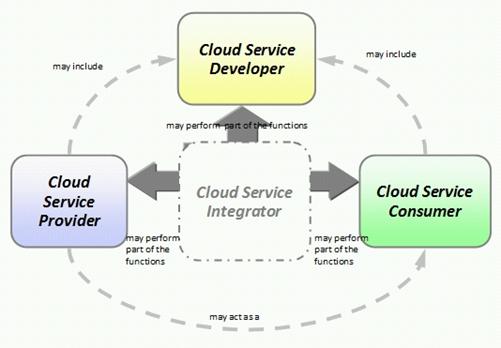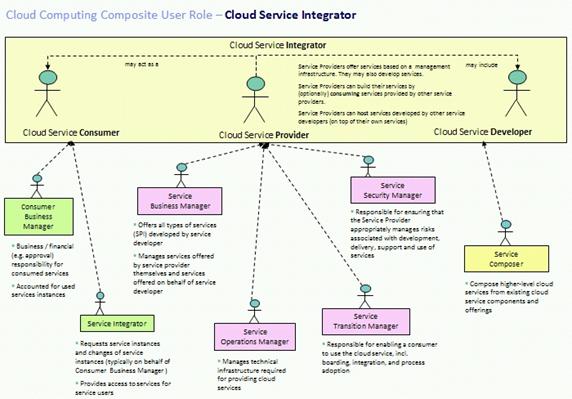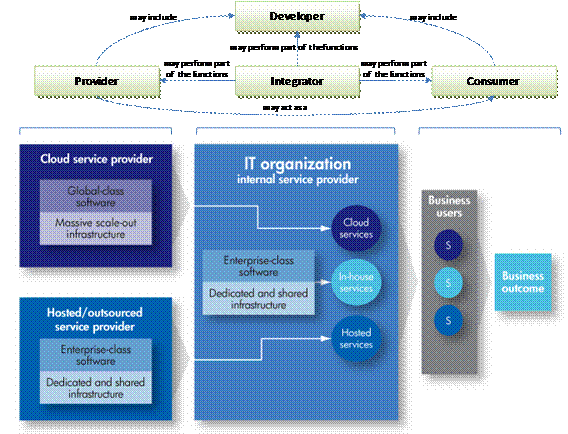Service-Oriented Cloud Computing Infrastructure (SOCCI) Framework – Viewpoints
This chapter describes the participants involved in the cloud computing model and their different perspectives. Participants have specific requirements from the cloud computing infrastructure. We will be elaborating on these requirements. The relationship of the base roles (Consumer, Provider, and Developer) and composite role (Integrator) are described below.

Cloud User Roles Relationship
Cloud Service Consumer Viewpoint
A cloud service consumer is a consumer of cloud computing, which includes the subscribers to cloud services and users of cloud services. In the private cloud domain, the users are within the same organization boundary as the provider. However, in the public cloud domain, the consumers can be either within the same organization as the provider (an extension of the private cloud community), or external to the provider. If the provider is external to the organization, then there should be an integrator role – see Cloud Service Integrator Viewpoint – within the organization for consuming cloud services.
In simple terms, consumer refers to an entity that utilizes any given service to perform an action and receive a result in return. For example, a customer opens a bank account. In this case, the entity is the “customer”, the action is “open”, and the result is the “bank account”. From a cloud computing perspective, consumers won’t notice when the infrastructure resources (e.g., CPU power, storage, etc.) are scaled up or down to satisfy their requests. In this particular example, the provider will manage the elasticity of those resources to deal with the demand of concurrent customers’ requests to open bank accounts. This is particularly crucial and useful when a consumer looks for provisioning on-demand supported by a flexible business model on a pay-per-use basis.
What is a cloud service consumer looking for from an infrastructure cloud perspective?
- Enhanced user experience
- Flexible business models and pricing (e.g., pay-per-use or click rate)
- On-demand provisioning
- Elasticity – perceived unlimited resources (scale up or down)
- Software developer platform
- SLAs – agreements for performance
- Risk transference
Cloud Service Provider Viewpoint
A cloud computing provider or cloud computing service provider owns, manages, and operates live cloud computing systems to deliver services to consumers – including third parties and end users. Usually this requires significant resources and expertise in building and managing data centers that have advanced technology to effectively and efficiently provide cloud services. Some organizations are realizing some of the benefits of cloud computing by becoming “internal or private” cloud providers and servicing themselves. Where they already own significant resource capacity (can handle peak loads) and management capabilities or cannot afford the risk of using public clouds, significant operational efficiencies and agility advantages can be realized by these organizations.
Companies without significant IT investment will benefit from the economies of scale, not having to engineer for peak loads, and minimal barrier to entry with minimal capital expenditure required.
For instance, Amazon.com was the first cloud service provider by modernizing its data centers which, like most servers or networks, were using as little as 10% of their capacity at any one time just to leave room for occasional spikes. This allowed small, fast-moving groups to add new features faster and easier, and they went on to open it up to outsiders as Amazon Web Services in 2002 on a utility computing basis.
A cloud service provider owns the assets that are required to create, deliver, and manage cloud services for consumers. A provider may provide services to internal users as well as external users. It may also be an exclusive supplier to a single consuming organization, or support a hybrid model providing both public and private cloud services from different cloud service layers. A provider may be responsible for various environments (e.g., a legacy environment, private cloud services, public, or a hybrid model) and its asset management to support the service consumer.
In simple terms, provider refers to an entity that responds to an action by providing a service or set of services. For example, a customer pays for a product with his credit card. In this case, the entity is the “customer”, the action is “pay”, and the results are the “approval of the credit card transaction” and “the product itself”. From a cloud perspective, a provider’s work is transparent to consumers. In this particular example, the provider will scale up or down infrastructure resources to cope with the demand of credit card transactions coming from different merchants simultaneously. This is particularly important and critical during seasonal periods (such as Christmas, New Year, etc.) where peak loads usually stress credit cards systems to their limits. Having a cloud computing service provider is fundamentally beneficial, particularly when an organization is looking to pay per use and outsource the responsibility of managing infrastructure resources with the appropriate elasticity.
What is a cloud service provider looking to offer from an infrastructure cloud perspective?
- Advanced virtualization – efficient use of resources
- Flexible business models and competitive pricing (e.g., pay-per-use or click rate)
- Economies of scale
- Hosted – as-needed provisioning
- Parallel – on-demand processing
- Elasticity – efficient and flexible infrastructure (scale up or down)
- Automated and autonomic operations
- Management – e.g., operational, business type services for infrastructure
Cloud Service Developer Viewpoint
A cloud service developer develops the technical as well as the business aspects of a (simple or higher-level) cloud service offering, which may be part of the organization of the cloud service consumer or cloud service provider. A cloud service developer leverages the development tools to develop and compose a service or set of services.
Cloud Service Integrator Viewpoint
A cloud service integrator is a composite role that combines a number of services that can be cloud-based, in-house, and/or outsourced to provide integrated services from the service provider to the service consumers whether business or end users.
We can view the integrator role from two perspectives – technical and business. The Service Integrator is predominantly concerned with the technical aspects of system integration. The Service Integrator’s skills and expertise come particularly into play in hybrid cloud environments. On the other hand, the business aspects of an integration project are handled by roles such as the cloud service provider’s Transition Manager. The latter will be negotiating and regularly communicating with the cloud service consumer’s Business Manager. The cloud service consumer’s Service Integrator will most likely be in close contact with the provider’s Operations Manager for all technical matters. All of these roles – i.e., the provider’s and consumer’s business and technical lead roles – ideally report back to the provider’s Service Manager who is responsible for ensuring the smoothest flow of services, business, and operational services.
The Service Integrator may also play a Service Composer role, which can be found within the Service Developer. Since this is a composite pattern, it may exhibit some of the sub-roles performed by the base roles (Consumer, Provider, and Developer). See Cloud Service Integrator Use Role Explained.

Cloud Service Integrator Use Role Explained
In simple terms, integrator refers to an entity that supplies business and IT services to another entity by integrating those services in such a way that they are transparent to the receiving entity, regardless of where those services are coming from. For example, a customer wants to view an auto racing video. The entity is the “Auto Racing Company”, the action is “View”, and the receiving entity of the service is the “Consumer”. From a cloud computing perspective, consumers won’t perceive what services and technologies have been employed and where they are coming from – being business process, software, platform, and infrastructure service provider or technical vendors. In this particular example, the integrator can use a combination of cloud services and technologies to address customers’ requests to provide auto racing streaming video. Please refer to Case Study of Cloud-Based SOI – Motorcars in the Cloud for details on the role of the cloud service integrator.
What is a cloud service integrator looking to offer from an infrastructure perspective to its organization?
- Elasticity – efficient and flexible infrastructure (scale up or down)
- Advanced virtualization – efficient use of resources
- Reduced Total Cost of Ownership (TCO) – by loose-coupling of consumer and provider
- Communicate and govern the Service-Level Agreements (SLA)
- Agility and to respond to business requests
Perspective on the Whole IT Service Supply Chain represents all the terms (Consumer, Provider, and Integrator) discussed previously in the context of the IT service supply chain.

[Source: White Paper: Avoiding Storm “Clouds” with ITIL [3].]
Perspective on the Whole IT Service Supply Chain